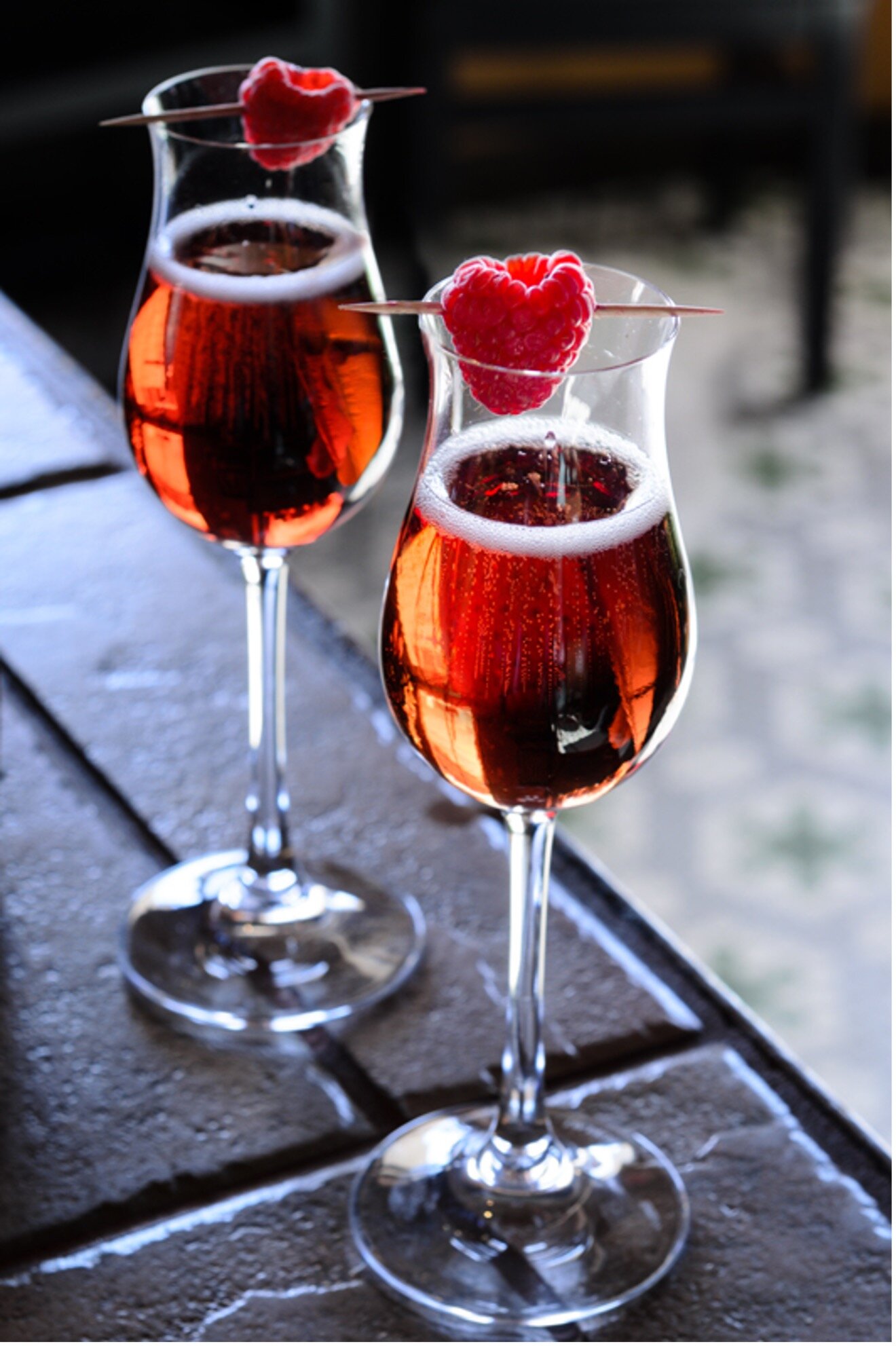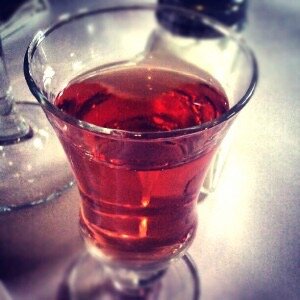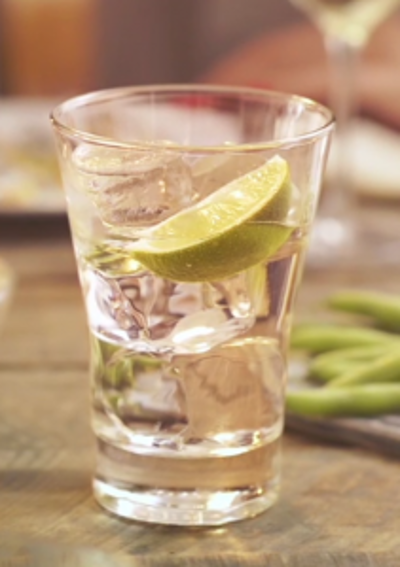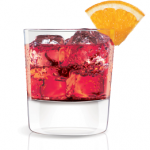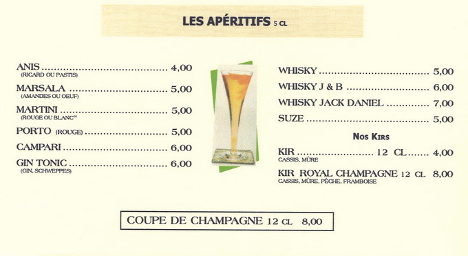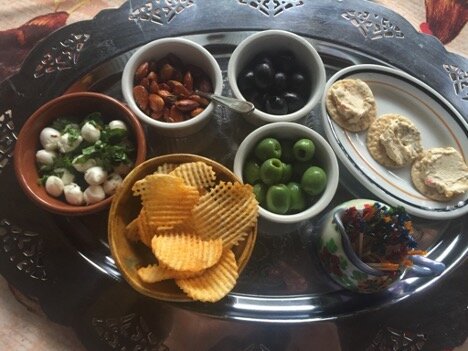The Five Best French Apéritifs
It’s France O’Clock somewhere, right? Time for an apéritif!
So, what is an apéritif? Is there a difference between an apéritif and a cocktail? And what should you serve with an apéritif? Read on to learn everything you need to know about apéritifs, including the five best French apéritifs.
A classic French apéritif: The Kir Royale. Photo by my good friend, Richard Swearinger.
If you’ve ever come across anything I’ve written about France, you know how passionate I am about the apéritif—that ritualistic pre-dinner drink that stimulates the appetite and enhances your mood without making your head spin. More interesting than a glass of wine, but not as overwrought and fuzzying as a full-blown cocktail, the apéritif is just the best way in the world to shrug off the cares of the day and ready your spirit for the joys to come—whether it's a simple Tuesday night meal at home or a dinner with friends.
No matter what else happens in our day, Dave (aka Mr. Sportcoat) and I generally stop everything at an appointed hour and sit down together for our little drink and a snack. Sometimes, it's the only drink I have in an evening; the pleasant feeling I get from it, and from stopping and relaxing and reconnecting with Dave, just gives me a bon feeling (as my Québecois friend Richard used to call it) that sustains me through the night. If I'm dining with friends, I'll usually switch to red wine for dinner.
What, then, do I serve most often as an apéritif? Here are five classic French apéritifs—plus see below for one drink you should never, ever serve as an apéritif.
Five Classic French Apéritifs
Some people say that the kir is passé. I say it’s still one of the best ways to shrug off the day’s worries with a a light, mood-lifting drink without making your head spin. Photo credit.
1. The Kir, of Course.
Surely—if you're a fan of France—you know this one, but I must mention it anyway. The kir (rhymes with beer) is the unofficial national apéritif of France; though it's from Dijon, it's served all over the country.
How to Make a Kir: Simply mix about 1 tablespoon crème de cassis with about 4 ounces of a dry white wine. What wine should use you use to make a kir? Traditionally, the wine used is Aligoté, a white wine from Burgundy, but take my word for it: All over France, they'll make it with just about any good, drinkable dry white wine they have. I personally like using an inexpensive white Bordeaux or Vouvray (a Chenin Blanc from the Loire Valley) but I'll also use whatever good dry white I have on hand, as long as it's not a big, heavy, overly oaky Chardonnay.
Here's what you might not know: Crème de Cassis is not the only pony in the Kir rodeo. The French very often use other fruit- or even nut-flavored liqueurs, such as liqueur de Pêche (peach liqueur), liqueur de mûres (blackberry) liqueur de framboise (raspberry), and—one of my favorites—crème de Chaitagne (chestnut liqueur).
When making a kir, why limit yourself to Crème de Cassis? The French don't! Many liqueurs can be used to make a great Kir—if you can find them.
The trick is, of course, finding these flavored liqueurs stateside. If you live on the coasts, I bet you can score some. I tend to bring it home from you-know-where. And if you're lucky, you can mail-order them, if you live in a state that allows this.
Start dinner off with one of these things, and I’ll guarantee you’ll enjoy everything that comes after it more fully.
Champagne — or a regional sparkling wine — is a fabulous apéritif. Photo credit.
2. Is Champagne an Apéritif? Bien sûr!
Travel into the Champagne region of France, and the apéritif is very often simply an uplifting glass of Champagne—it's a great apéritif that never fails to set a fine tone for the night.
What's better than Champagne? Apéritifs made with Champagne. A Kir made with Champagne is called Kir Royale; you can make it with crème de cassis, of course, but you can also use any of the fruit-flavored liqueurs mentioned above. Those are the simplest.
Of course, many drinks are made with Champagne — including the French 75 (with gin) and the classic Champagne Cocktail (with Cognac). But in my view, once they include a hefty pour of a spirit, they're no longer an apéritif, but a cocktail—and that's a different kind of pleasure (more on cocktails versus apéritifs, below).
For Champagne cocktails that work best as apéritifs, stick to fruit liqueurs and such.
Martini Bianco, a brand of white vermouth, served on the rocks makes a great apéritif.
3. Can You Serve Fortified Wines As an Apéritif? Yes, indeedy-do.
Though we often think of fortified wines, such as Port, Madiera, and Marsala, as after-dinner drinks, the French serve them equally often — chilled and in small portions — as apéritifs. You see, something viscous and lightly sweet (but with intrigue) stimulates the appetite better than, say, a light, citrusy Sauvignon Blanc or other super-dry wine. The French have figured this out. Why haven't we?
A few terrific fortified wines that the French serve as apéritifs include:
• Port (red or ruby--generally not tawny). Serve chilled.
• Vermouth: Fortified wines with aromatic herbs and spices. You'll generally drink sweet vermouth for your apéritif, the most famous of which is the Martini brand, which comes in white, red, or rosé. These are fabulous apéritifs. Serve these chilled, with a couple of ice cubes.
• Madeira: Either dry or sweet can be served as an apéritif. Serve chilled.
• Marsala: Again, either dry or sweet can be served as an apéritif. Serve chilled.
• Pineau des Charentes: Harder to find stateside, but definitely worth seeking out, this fortified wine is made in the Cognac region. It's a golden sip with the luscious density of port, but with bright, honeyed orchard-fruit flavors like golden apples, pears and apricots. My favorite of all the French fortified-wine apéritifs. Serve chilled, in 3- to 4-ounce portions.
And if you ever travel in the Southwest of France, be sure to order a Floc de Gascogne — a cousin of Pineau des Charentes, but made with Armagnac instead of Cognac. I’ve never succeeded in finding it state-side.
Mr. Sportcoat (sans sportcoat), drinking un perroquet: Pastis with crème de menthe. No, we don’t try to match our outfits to our drinks. Not every day, anyway.
4. The Go-To South-of-France Apéritif: Pernod, Pastis, Ricard, etc.
These anis-flavored apéritifs, classic in Provence, are not for everyone (Mr. Sportcoat enjoys them; I'll have one upon my arrival to the Mediterranean, just to ease into a sense of place). To serve Pastis, you pour one part over ice, then add water (about 4 parts). Generally, the water is served separately, so that the guest can add water to taste.
The real fun, however, begins when you start adding a flavor to the Pastis. The colors of the drink become amazing, and its anis flavor a little less licorice-y. Two favorites:
La Tomate: This drink is named for its color (in this case, a pretty pink). To make, pour one part Pernod (or similar) into a glass; add 1 dash grenadine syrup and add a few ice cubes. Fill glass with four parts cold water. The results taste like a very adult version of Good-and-Plenty candy.
Le Perroquet: Again, this drink is named for its color (an amazing green). To make, pour one part Pernod into a glass; add 1 dash crème de menthe syrup and a few ice cubes. Fill glass with four parts cold water. The mix of cool mint and smooth anis makes an amazingly refreshing drink.
Campari on the rocks. It’s a classic apéritif.
5. Those Amazing Amari — Apérol and Campari et al.
Although they hail from Italy, not France, the French love these bitter (amari, in Italian, amer, in French) spirits, especially during the apéritif hour. And if you just will not get on the lightly-sweet-apéritif train with me, then drinks made with apérol and Campari are for you.
These refreshingly bitter, ruby-red apéritifs are flavored by top-secret blends of herbs, spices and fruit peels (bitter orange peels and wild herbs come mostly to mind when I sip). Campari is more bitter (and higher in alcohol content — 23%) than Apérol (11%), but both are incredibly refreshing.
Best ways to enjoy Campari and Aperol:
• Campari (or Apérol) and Soda: One part of the spirit to two parts soda, on the rocks.
• Campari (or Apérol) on the Rocks: Just pour about 2 ounces on the rocks. Simple and refreshing. Add a lemon or orange wedge.
• Apérol Spritz: Consider this a Kir Royale for those who don't want anything sweet in their sip. Place ice in a big-globe wineglass; add 2 ounces Prosecco, 1 1/4 ounces Aperol, and a splash of Soda water.
• Américano: 1 part Compari and 1 part Red Vermouth plus a splash of soda. A beautifully complex drink that takes the edge off the bitterness of the Campari, but it's still not sweet!
• Negroni: It's an Americano with 1 part gin added, and no soda. But to me, with all that booze, this veers into the cocktail camp—it's not my idea of an apéritif.
More Things to Know about Apérififs and l’Apéro
Roughly: “No can do! It’s apéritif time!”
What is l’apéro? Is l’apéro just a hipster way of saying apéritif?
Not exactly. When people talk about an apéritif, they're generally talking about the little drink itself (though keep in mind that the drink is rarely served without a little nibble alongside).
When people talk about the apéro, however, it refers to the entire ritual of the drink and the little bite to eat with it—as well as the time you take to relax and enjoy it all with friends.
Can I serve red wine as an Apéritif?
Non! Most red wines are meant to be enjoyed with a substantial meal; they're not apéritifs. They're not refreshing on their own and they don't arouse the appetite.
However, if someone you're hosting specifically requests a glass of red to start off the evening, then, because you're an excellent host, you will gladly and graciously pour a glass. Because, of course, you are not the kind of know-it-all who would embarrass a guest by mentioning that red wines aren't meant to drink as an apéritif. N’est-ce-pas?
Can cocktails Be Served as an apéritif? What's the difference between a cocktail and an apéritif?
Sigh. Yes, you can serve a cocktail as an apéritif, if you must. But once you get high-proof spirits in the mix, they're a different experience than a classic French apéritif, which is generally not a high-proof drink. Apéritifs give you a lift; cocktails give you a buzz.
But I must admit that in France, sometimes cocktails are served as apéritif; one of the most common cocktails served as an apéritif is, of all things, a gin and tonic. I've also seen very small glasses of whisky on ice served as apéritifs. And I’ve also learned that in recent years, single-malt Scotches are incredibly popular apéritifs in France. Ah, globalization.
Can Wine Be Served as an apéritif?
Yes. Rosé and white wines are sometimes served as apéritifs, especially at very casual gatherings. I've been served both in French homes; however, it's been more common, in my experience, to be served one of the apéritifs I've mentioned above.
Question: What Do I Serve with an Apéritif?
Good question, because remember: The apéritif is rarely ever served without a nibble. (As a great restaurateur once told me, “Reasonable people eat when they drink.” That bite doesn't have to be elaborate (some nuts or olives or well-chosen chips will do, if you're not entertaining). But when a friend stops by, I try to make it nice by putting a few things out. Not too many and not too much. It's not about grazing until you're full and no longer want dinner. Because dinner is its own separate pleasure.
What to serve with an apéritif: Don’t go overboard. Here’s the type of thing I'll serve if having a friend stop by: Mozzarella pearls with basil and olive oil, almonds, olives, crackers with a spread I have tucked in the fridge, and some chips.
Remember: The apéro is not meant to be dinner. That would be an apéritif dînatoire (roughly, a heavy cocktail/hors d'ouevres buffet), another topic for another time.
Did you enjoy this post? Be sure to sign up for my newsletter, which I send about once a month. Sign up here.
And to keep up with what I’m cooking and great French finds, follow me on Facebook: Everyday French Cooking, or on Instagram at Wini_Moranville.
P.S.: Here’s how to support my work on this blog — with no added cost to you
And finally, if I missed one of your favorite apéritifs, tell me about it! I’d welcome your comments.

